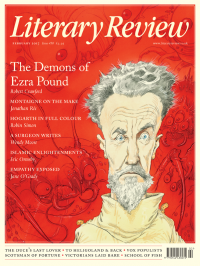Nicholas Roe
Last Words
Deaths of the Poets
By Paul Farley & Michael Symmons Roberts
Jonathan Cape 414pp £14.99
At Plymouth last year I visited the home of Charles Armitage Brown, John Keats’s friend and collaborator. Set back behind trees, Brown’s Regency villa resembles Wentworth Place, the home he had shared with the young poet, who died, aged twenty-five, of tuberculosis. For fifteen years Brown thought about writing a memoir of Keats, but was unable to confront the anguish of doing so. Then, settled at Plymouth in 1836, he made a start. To offset his friend’s ‘disappointment, his sorrows, and his death’, Brown began with Shelley’s Adonais, the great Romantic elegy in which Keats hastens to ‘the abode where the Eternal are’. Awaiting his arrival is the pale form of another young poet who had destroyed himself, aged seventeen, with a cocktail of opium and arsenic: Thomas Chatterton.
Poets Paul Farley and Michael Symmons Roberts contend that the perilous, self-destructive lives of Chatterton and a few other Romantics initiated a myth of doomed genius: that poetic achievement comes when life is pushed fatally to its limits. This Chatterton myth, they suggest, explains the ‘skewed’ popular image of poets

Sign Up to our newsletter
Receive free articles, highlights from the archive, news, details of prizes, and much more.@Lit_Review
Follow Literary Review on Twitter
Twitter Feed
The dropping of the atomic bomb on Hiroshima in August 1945 has long been regarded as a historical watershed – but did it mark the start of a new era or the culmination of longer-term trends?
Philip Snow examines the question.
Philip Snow - Death from the Clouds
Philip Snow: Death from the Clouds - Rain of Ruin: Tokyo, Hiroshima, and the Surrender of Japan by Richard Overy
literaryreview.co.uk
Coleridge was fifty-four lines into ‘Kubla Khan’ before a knock on the door disturbed him. He blamed his unfinished poem on ‘a person on business from Porlock’.
Who was this arch-interrupter? Joanna Kavenna goes looking for the person from Porlock.
Joanna Kavenna - Do Not Disturb
Joanna Kavenna: Do Not Disturb
literaryreview.co.uk
Russia’s recent efforts to destabilise the Baltic states have increased enthusiasm for the EU in these places. With Euroscepticism growing in countries like France and Germany, @owenmatth wonders whether Europe’s salvation will come from its periphery.
Owen Matthews - Sea of Troubles
Owen Matthews: Sea of Troubles - Baltic: The Future of Europe by Oliver Moody
literaryreview.co.uk